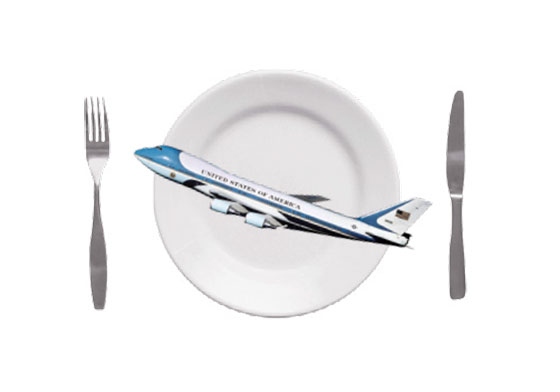
After four years of laboring over bailouts and health-care reform and confirmation fights, White House aides heading for the exits in the coming weeks will face one final hurtle—a checkout process resembling a bureaucratic scavenger hunt. Each outbound staffer is presented with a checklist that must be signed by eleven different administrative offices in three different buildings. Laptops must be returned to Operations in Room 1; notebooks and papers go to Room 85 for archiving; official passports are to be surrendered at 1800 G Street. “If you’re going to cry, it usually happens when you turn in your BlackBerry,” an Ops official told me when I went through my own checkout two years ago. But it’s the next-to-last task that can be most daunting: settling your meal tab from Air Force One.
It is a curious fact of White House life that when flying on the Big Bird—a conveyance whose $180,000-per-hour bill is footed by the taxpayer when the plane is on official business—travelers do not get free meals. On foreign trips, the State Department foots the hospitality bill, and during campaign jaunts, Obama for America paid for anyone designated as political staff. But for the sizable retinue of functionaries on typical domestic flights, it’s their personal credit cards that will be charged—automatically, per ethics regulations, even if a staffer choses not to eat. Captive political travel can get pricey rather quickly, as reporters who covered the Romney campaign have learned, but this is particularly a problem on Air Force One owing to the fulsomeness of military hospitality. A late-night snack of “sliders” could well turn out to be full-scale bacon cheeseburgers. Lunch might come with a coupé of ice cream.
The precise authorship of the gut- and wallet-busting menus is tricky to pin down. Major Michelle Lai, a public-affairs officer with the 89th Airlift Wing, which oversees operation of the executive fleet, says that different meal offerings are presented to the White House Travel Office, whose staffers make the final call. (They wouldn’t comment for this story.) Regardless, each leg of travel ends up costing about $20, depending on how many meals are jammed in. An entry-level but frequent-flying employee, living in a group house in Adams Morgan and scraping by on a salary in the mid-thirties, could see debits adding up to thousands per year. “On my own,” says Arun Chaudhary, who for two and a half years served as presidential videographer (and in August published the memoir First Cameraman), “I would definitely have been skipping lunch, just for financial reasons.” The effect on staffers now decamping for the private sector, as they arrive at Room 25 with checklists in hand, is to have their memories of presidential flight—cruising the skies in the splendor of the world’s most rarefied aircraft—yanked earthward in a last AmEx reckoning of pulled pork, Texas toast, and tricolor nachos. “It was an amazing honor to be on Air Force One, obviously,” says Chaudhary. “But I found the billing process slightly cruel.”
Have good intel? Send tips to intel@nymag.com.